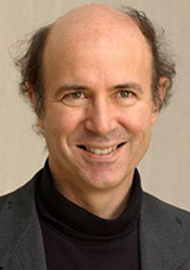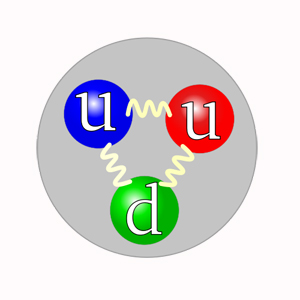
Strong but free — part II
As we saw in the first part of this article, the early 1950s were an experimental gold mine for particle physics, with new particles being discovered almost every week. What was missing, though, was a theory to describe the new discoveries. It took another decade and two Nobel Prizes before the particle zoo was finally tamed.
Quarks to the rescue

Frank Wilczek.
In 1964 Murray Gell-Mann and George Zweig independently proposed that all those different particles weren't themselves fundamental, but made up of even smaller particles which Gell-Mann called quarks. Quarks, they suggested, came in three colours and it was the way differently coloured quarks fit together that determined the nature of the larger particle they formed.
The idea of quarks made things wonderfully simple, but as Dyson already pointed out, it's no good predicting particles if nobody then discovers them. And for quite a while nobody did. "People looked in exotic places. They searched in moon rocks, all kinds of things, and no quarks," says Wilczek. So people suspected that quarks were clingy: they could only exist in groups that formed larger particles, a phenomenon that is now known as confinement. But, as Wilczek has written, "Giving it a dignified name doesn't make it less weird." That kind of behaviour was entirely unknown in the context of quantum field theory, casting further doubts on its validity.
In the late 1960s experimental evidence for the existence of quarks finally came. Using energetic photons to look inside protons at the Stanford Linear Accelerator (SLAC), Jerome Friedman, Henry Kendall and Richard Taylor saw that protons really were made up of things that looked like quarks. In 1969 Gell-Mann received the Nobel Prize in Physics for their prediction, and Friedman, Kandall and Taylor were honoured with the same prize in 1990.
Why is energy the reciprocal of distance?
Quantum theory loves a duality; one description or value is never enough. The state of a system can be equivalently described by a wave function and a Hamiltonian matrix. Superposition says that, before you measure it, the property of something can, and does, have more than one value at the same time. All the fundamental ingredients in the universe — whether matter or forces — are both particles and waves. It's this last one, the wave/particle duality, that explains this particular duality: in quantum theory energy is like the reciprocal of distance.
In 1924 Louis de Broglie came up with equations that related the particle-like and wave-like properties of any fundamental particle: the momentum p (a particle-like property, it is usually defined as mass times velocity, p=mv) is inversely proportional to the wavelength, λ. That is:
p=h/λ,
where h is Planck's constant. Momentum is a measure of a particle's energy, while wavelength is (obviously) a measure of length (the length of one complete cycle of the wave — you can think of it as the distance between two neighbouring peaks). So if you are dealing with things at high energies then you are dealing with things at short distances. Conversely, if you are dealing with things at lower energies the distances involved are large.
The experimental observations, however, posed another mystery. The power that is unleashed when an atom is split shows just how strong the strong force is. Quarks stick together to form the bigger particles that form atoms because they feel that strong force. Yet, experiments seemed to show that when quarks were hit very hard, the effect of that strong force simply vanished – the quarks behaved as if they felt no force at all; they behave like "free" particles. In quantum theory, high energies correspond to small distances (see the box). "So over very short intervals in space and time, quarks seem to move freely," explains Wilczek. "But if they keep doing that, and start to threaten to get out of the proton, then they inevitably get pulled back."
"That was, on the one hand, encouraging for quantum field theory, in the sense that it did appear that there were simple building blocks, that behaved simply in some circumstances. On the other hand, it seemed very peculiar, to say the least, that you had a force that grew with distance. There was a big question whether that could be reconciled with quantum field theory."
Free, at last
It was Wilczek, together with his supervisor David Gross, who solved the riddle in 1973, when Wilczek was only 22. "I had been a graduate student in maths, but I was floundering, so I wanted to move over to physics," he recalls. "I took a course from David Gross on quantum field theory. We hit it off, and we started working together."
One of the lessons from the earlier days of quantum field theory had been that the vacuum — supposed empty space — is in fact seething with activity (see here to find out more). So-called virtual particles can pop in and out of existence for fleeting moments of time and they can effect what we observe about non-virtual particles. It's a "music of the void," as Wilczek has called it. In fact, it's the contribution of increasing numbers of virtual particles that leads to the infinite sums mentioned above.
In QED the particle that exerts the force is the electron by virtue of its negative charge. If you are trying to look at an electron, the attempt tends to be frustrated by its virtual entourage: pairs of virtual electrons and their positively charged anti-twins, positrons, crowd around the original particle (see the figure on the right). If you try to measure the electron’s charge, which dictates the strength of the electromagnetic force (the coupling constant), you can't. All you will be able to measure is the charge of the whole assembly, as the virtual particles screen the electron’s bare charge. The virtual particles actually cancel some of the original electron's charge. So as you get closer to the electron, there will be fewer virtual particles in the way to screen the bare charge, and what you measure, the effective charge, goes up.

Virtual electron-positron pairs clouding around a central electron with positively charged positrons attracted to the centre.
Wilczek and Gross realised that with the strong force, the screening goes the other way. A quark also comes with a cloud of virtual particles, but in this case, they don't reduce, but instead add to the original quark's strength. This is why the strong force gets stronger the further away you are from a source. And it also explains why quarks, when knocked about hard at high energies behave like they are feeling no force at all, even though they interact strongly and are confined together with other quarks — high energies can for short periods knock them out of their reinforcing virtual cloud, leaving them only with their relatively weak intrinsic strength.
This behaviour of quarks is called asymptotic freedom. It's incredibly useful: at high energies, or equivalently, short distances, the strength of the strong force, its coupling constant, is small, just as like coupling constant in QED. This means you can play the same game as had been played 25 years earlier for QED: namely, you ignore terms further down the infinite sums. In other words, the perturbative techniques that worked for QED and had been fought for so hard now worked for the strong force too, at least at high energies.
"That is very practical," says Wilczek. "That is what makes it possible to understand what happens at very high energy accelerators, it turns out, because most of what happens there is the strong interaction. Asymptotic freedom tells you that [at high energies] things really get simple. That is a real gift, because if things got more complicated at high energies, they would be hopeless."
The true gift, however, was more fundamental. The physical pictures that physicists were grappling with came with clear mathematical formalisms. And since no one knew how the strong force worked, there were several such formalisms, several quantum field theories. Which one was the correct one was anyone's guess. But Wilczek and Gross were able to show that only one of these candidate theories would allow this process of anti-screening to occur — it's now called quantum chromodynamics. "This was like a gift from heaven, it could not be better. If you took this particular set of clues seriously, you were led to an absolutely unique theory of the whole business.[...] I remember saying to David Gross, 'If this is right, we are going to get a Nobel Prize for this.' " Gross didn't agree, but Wilczek was right. The honour was bestowed on them and David Politzer, who had independently came up with very similar results, in 2004.
It now seems clear that the theory is indeed correct and mathematically consistent. "No working physicist, no practical physicist, has any serious doubt that I know of that the theory exists," he says.
Very un-perturbing
The discovery of quantum chromodynamics (QCD) had another dramatic consequence. Asymptotic freedom comes with a flip-side, imaginatively called infrared slavery: at greater distances or lower energies, the strong interaction is strong, so much so that it keeps quarks in their confinement. If you want to calculate phenomena at those distance and energy scales, you can no longer simply ignore the terms further down your infinite sums, since the coupling constant is too large.
Not long after Wilczek and Gross' discovery, however, Kenneth Wilson came up with a powerful way around this problem. A challenge in many physics situations is that space and time are thought of as continuous. When you’re trying to predict the weather, for example, you have no hope of predicting it at every point on Earth and every moment in future time — the calculations are just too complicated. Meteorologists therefore chop space up into a grid and time into discrete steps, and attempt to predict the weather only for those grid points and time steps.

A proton is made of two up quarks and one down quark. Image Arpad Horvath.
Wilson realised that something similar was possible for QCD. He formulated the theory on a spacetime grid, a lattice, rather than continuous space and time. When you are doing this you are ignoring things on smaller scales, but it's precisely asymptotic freedom that allows you to do the extrapolations necessary to make predictions about reality. "It is all under control because the fluctuations you are neglecting are the ones at really short distances," explains Wilczek. "And that is where the coupling is small. If you do not have asymptotic freedom, you cannot do that. You are limited to perturbation theory."
The calculations are still very difficult: indeed, some of the world's fastest supercomputers have been built just for them. Those computers don't use elegant formulae to solve the relevant equations, rather they use highly sophisticated algorithms to approximate solutions. Yet, lattice QCD has been an amazing success. It has made it possible, for example, to determine the mass of a proton to an error of less than 2% (it's 1.672621777(74)×10−27 kg), something Wilczek and his colleagues never dreamed was possible when they came up with asymptotic freedom. It seems then, that QCD is the correct theory for the strong force.
But there is another twist to the story. The strong force seemed hard to deal with at first because it was much stronger than electromagnetism at the distance and energy scales people could measure, so the perturbative techniques of QED wouldn’t apply. In the end the strong force was saved by the fact that it gets weaker at shorter distances and higher energy scales. But hang on a second. Wouldn't the same apply to the electromagnetic force? And since in this case we have screening, rather than anti-screening, the coupling constant should get larger at shorter distances and higher energy scales. Could it be that it gets so large that perturbative techniques don't apply here either? This possibility had already been recognised, by Dyson as well as the Russian physicist Lev Landau, in the early 1950s. Landau thought his argument meant that quantum field theory was dead in the water. QED would still work for the energy and length scales we are actually able to observe, but in principle the perturbative approach so intimately tied to quantum field theory seemed doomed.
But was Landau's pessimism justified? Find out in the next article.
About this article
Marianne Freiberger and Rachel Thomas are Editors of Plus. They interviewed Frank Wilczek in February 2013. They are also very grateful to David Kaiser, a historian of physics at Massachusetts Institute of Technology, for an illuminating conversation and his excellent book Drawing theories apart.
But they owe most of their tentative understanding of quantum field theory to Jeremy Butterfield, a philosopher of physics at the University of Cambridge, and Nazim Bouatta, a Postdoctoral Fellow in Foundations of Physics at the University of Cambridge. Many thanks to them for their many patient explanations and help in writing this article.